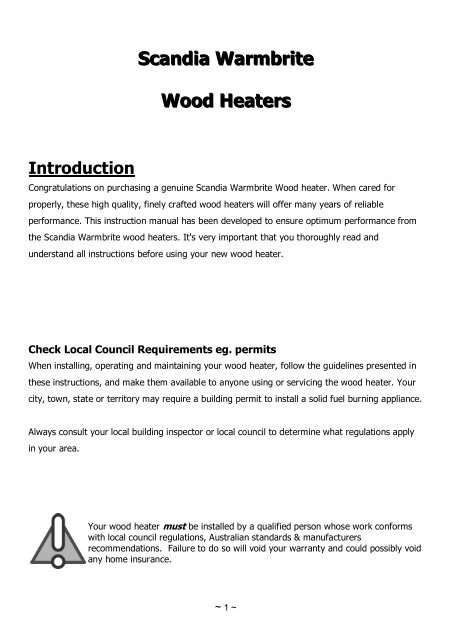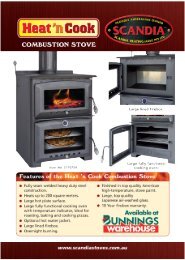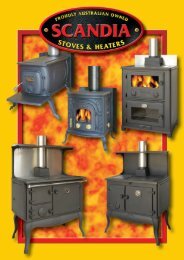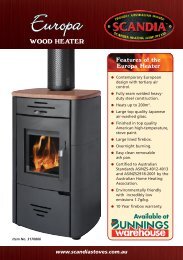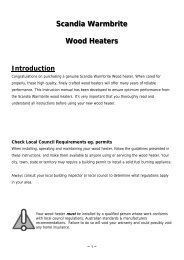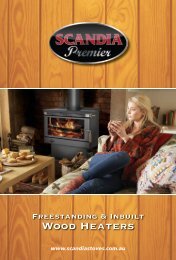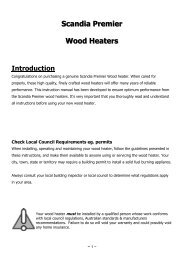Download manual & warranty information - Scandia Stoves & Spares
Download manual & warranty information - Scandia Stoves & Spares
Download manual & warranty information - Scandia Stoves & Spares
Create successful ePaper yourself
Turn your PDF publications into a flip-book with our unique Google optimized e-Paper software.
<strong>Scandia</strong> Warmbrite<br />
Wood Heaters<br />
Introduction<br />
Congratulations on purchasing a genuine <strong>Scandia</strong> Warmbrite Wood heater. When cared for<br />
properly, these high quality, finely crafted wood heaters will offer many years of reliable<br />
performance. This instruction <strong>manual</strong> has been developed to ensure optimum performance from<br />
the <strong>Scandia</strong> Warmbrite wood heaters. It's very important that you thoroughly read and<br />
understand all instructions before using your new wood heater.<br />
Check Local Council Requirements eg. permits<br />
When installing, operating and maintaining your wood heater, follow the guidelines presented in<br />
these instructions, and make them available to anyone using or servicing the wood heater. Your<br />
city, town, state or territory may require a building permit to install a solid fuel burning appliance.<br />
Always consult your local building inspector or local council to determine what regulations apply<br />
in your area.<br />
Your wood heater must be installed by a qualified person whose work conforms<br />
with local council regulations, Australian standards & manufacturers<br />
recommendations. Failure to do so will void your <strong>warranty</strong> and could possibly void<br />
any home insurance.<br />
~ 1 ~
Wood Heater Safety<br />
When properly maintained and operated your wood heater should give you many years of<br />
service, however there are important safety aspects of these products that you need to be aware<br />
of when operating a wood heater.<br />
1. Never place combustible items such as but not limited to furniture, fabric or wood within the<br />
specified clearances to combustibles.<br />
2. The burning of wood gives off gases which can be extremely dangerous. Wood heaters are<br />
designed so that under normal operating circumstances these gases pass up the flue<br />
chimney system and cannot escape into your home, however it is important that your flue<br />
system is properly installed and that you check all joints regularly to ensure that there are no<br />
cracks or gaps, check the door sealing rope and replace when damaged. We recommend a<br />
smoke alarm be fitted in rooms where wood heaters are installed. Do not use wood heater in<br />
a room where negative pressure conditions may occur, such as through the use of extraction<br />
fans unless an adequate air supply into the room is ensured, as this may draw air through<br />
the wood heater and cause products of combustion to escape into the room.<br />
3. This appliance is designed to specifically burn dry hardwood. Do not burn rubbish,<br />
driftwood, flammable liquids or any substance containing salts or corrosives.<br />
3. Creosote and soot may accumulate in your flue pipe and chimney. This may ignite, causing a<br />
chimney fire. If you suspect a chimney fire close down the air controls on the wood heater, if<br />
the fire persists evacuate people from the building and call the Fire Brigade. To prevent the<br />
accumulation of soot or creosote, check flue and chimney regularly and clean as necessary.<br />
Good burning, hot wood heaters will generally cause a lot less build-up than slow burning<br />
wood heaters, likewise dry wood will cause less build-up than wet wood. We recommend a<br />
fire extinguisher be available where wood heaters are in operation. In the event of a chimney<br />
fire do not re-light the wood heater until it and the flue chimney system have been<br />
thoroughly checked and repaired as necessary.<br />
4. Wood heaters get extremely hot and should not be touched when lit. When young children<br />
are in the area, we recommend the use of a suitable fire guard around the wood heaters.<br />
Always wear protective gloves when reloading wood heater.<br />
5. Never over-fire your wood heater. If external parts of your wood heater are glowing red then<br />
the wood heater is over-firing and your draught settings should be reduced. Never interfere<br />
with the draught mechanisms or adjust your air settings outside those limits set when the<br />
wood heater is manufactured. Never use a fan to supply air to the wood heater or to extract<br />
air from it.<br />
6. All users of the wood heater should be aware of the contents of this <strong>manual</strong>. Please leave<br />
this <strong>manual</strong> where it is accessible to wood heater users and do not allow anyone to use the<br />
wood heater that is unfamiliar with its correct operation.<br />
7. Never use the wood heater if any parts are missing or damaged, only use genuine parts as<br />
replacements. Never modify your wood heater.<br />
~ 2 ~
Before Installing your wood heater<br />
You need to consider the following to ensure the safe operation of your wood heater.<br />
Provision of adequate air to support efficient combustion of the fuel.<br />
A well sealed flue/chimney system, hereinafter referred to as the “flue system”.<br />
The protection of combustible materials in proximity of the wood heater.<br />
Adequate provision air<br />
It is essential for the safe and efficient use of your wood heater that you provide an adequate air<br />
supply to your wood heater. This may mean the provision of an outside air supply to the room,<br />
especially if there are extraction units such as cooker hoods or clothes dryers in the vicinity.<br />
Failure to do so will mean that fuel is burned inefficiently causing smoke and blackening the glass<br />
and may also cause smoke to come back into the room. As a simple check for this open a door or<br />
window in the room and check if the wood heater burns more efficiently.<br />
Installation<br />
Well sealed flue system<br />
Under no circumstances should you use aluminum or galvanized steel pipes for your wood heater<br />
flue.<br />
Always fit pipes with the narrow crimped side down, this allows any creosote to run down the<br />
inside of the pipe and not to come out and cause an unsightly mess and possible fire hazard.<br />
Pipe bends should be kept to a minimum and we do not recommend using more than 2 bends on<br />
any installation. Flues must not pass through ceilings, floors, attics, roofs, or combustible walls<br />
without adequate and approved insulation being provided to protect combustible materials.<br />
The chimney and flue provide a means of taking combusted fuel from the wood heater, as well<br />
as a draught to enable the wood heater to work. It is essential that the flue system is kept in<br />
good condition and there are no breaks or cracks allowing contact with any other combustible<br />
materials of the house. It is also essential that the flue system is kept clean and seals are<br />
maintained to ensure the draught is not lost.<br />
The open end of the flue system must be above the height of the apex of the building and any<br />
other obstructions, such as trees, which are within 3 meters (10ft) of the flue system. Failure to<br />
do this will affect the efficiency of the wood heater and may cause down draughts which will<br />
mean dangerous products of combustion are emitted into room.<br />
Under no circumstances should the flue pipe be less than 6” (152mm) internal diameter.<br />
~ 3 ~
Clearances to combustibles<br />
It is extremely important that you respect required installation distances and that you respect<br />
local installation regulations. This is for your safety! The manufacturer is not responsible for the<br />
product, if it is not installed following these recommendations. These clearances may only be<br />
reduced by means approved by the regulatory authority.<br />
A combustible surface is anything that can burn (i.e. plaster, wall paper, wood, fabrics etc.)<br />
These surfaces are not limited to those that are visible and also include materials that are behind<br />
non-combustible materials. If you are not sure of the combustible nature of a material, consult<br />
your local fire officials.<br />
Hearth requirements<br />
The floor protector must consist of 6.0mm thick cement fibre sheet which has a thermal<br />
resistance of 0.8m 2 K/W, per 4mm thickness or equivalent.<br />
Parallel Installation<br />
Corner Installation<br />
A<br />
C<br />
C<br />
H<br />
B<br />
F<br />
F<br />
D<br />
E<br />
D<br />
E<br />
G<br />
G<br />
SCWB140 SCWB200 SCWB300<br />
A – Rear of heater to rear wall 360mm 225mm 150mm<br />
B – Side of heater to side wall 700mm 250mm 250mm<br />
C – Rear corner of heater to wall 550mm 150mm 100mm<br />
D – Hearth to door hinge 200mm 200mm 200mm<br />
E – Front of heater to hearth front 350mm 300mm 300mm<br />
F – Minimum hearth depth 790mm 770mm 850mm<br />
G – Minimum hearth width 745mm 900mm 1000mm<br />
H – Rear of heater to centre of spigot 125mm 180mm 205mm<br />
~ 4 ~
For connecting into a standard installation:<br />
The following drawing is meant as a guide only. Your wood heater must be installed by a<br />
qualified person whose work conforms with local council regulations, Australian/New Zealand<br />
standards (AS/NZS 2918:2001) & manufacturers recommendations.<br />
~ 5 ~
1. Locate wood fire in its proposed position according to manufacturers recommendations.<br />
2. Use a plumb bob to mark the ceiling in line with the centre of the flue collar.<br />
3. Check that the outer casing will clear all combustible materials by 25mm. Determine<br />
positions of noggins to avoid cutting, otherwise headers must be installed for strength.<br />
4. Cut a 250mm diameter hole in the ceiling. Directly above cut a hole in the roof to<br />
accommodate outer casing.<br />
5. Fix the angle brackets to the joists so that the drop box (first length of located casing) is<br />
located in the centre of the hole.<br />
6. Position the drop box between the angle brackets, keeping a 25mm clearance to<br />
combustibles. The located end of the drop box must protrude no less than 150mm down<br />
from the ceiling. Fix the drop box to the angle brackets.<br />
7. Add the remaining casings to the required height. Australian/New Zealand Standards state<br />
that “the flue pipe shall extend not less than 4.6m above the top of the floor protector”. If<br />
the flue pipe is within 3 metres of the ridge, the flue pipe must protrude at least 600mm<br />
above the ridge of the roof. If the distance from the ridge is more than 3 metres, the flue<br />
pipe must protrude at least 1000mm above roof penetration. Additional lengths of casing<br />
and flue may be required to achieve this. The flue pipe must be more than 3 metres from<br />
any nearby structure.<br />
8. Install roof flashing (supplied by others).<br />
9. Secure the Ceiling Collar in place using ceramic spacers and screws provided.<br />
10. Insert crimped end of decorative mesh into drop box. The locating tags in one length of<br />
decorative mesh rest on the heater flue collar. The solid heat shield section of the<br />
decorative mesh is to face the wall.<br />
11. Feed stainless steel flue through perforated flue and drop box through to the required<br />
height. Assemble flue pipes tight together as you go ensuring seams are straight. Secure<br />
each joint with three stainless steel rivets spaced equally. Clean any finger prints or oils off<br />
stainless steel flue with methylayted spirits.<br />
12. Trim the inner flue to the same height as the outer casing. Place cover cone and cowl over<br />
stainless steel flue & push cover cone over gal casing. Fix with stainless steel pop rivets.<br />
For connecting into existing Chimney:<br />
The Chimney should be swept prior to installation. The Chimney must not have any hollow<br />
sections present. The connecting flue pipe must be sealed to the chimney with fire cement and<br />
high temperature resistant rope as required. This is usually done into a register (Blanking) plate<br />
with an access door/hatch to enable chimney sweeping. Flue pipe must continue for the full<br />
length of the chimney. The top must be suitably weather sealed with a chimney to flue pipe<br />
adaptor sealed in place with mortar. The flue must be completed with a cowl. Note there should<br />
not be any flue exposed to the elements.<br />
~ 6 ~
Firebox Assembly:<br />
Remove all loose items from the fire box. First install the top baffle. Place the baffle in the<br />
firebox with the bent edges facing the same direction as in the below drawings. Lift the front<br />
edge of the baffle up and rest it on the top of the front baffle support lugs, continue to lift the<br />
rear of the baffle over the rear lugs, you will need to slide the baffle forward to clear the rear<br />
lugs. Once the rear of the baffle is above the rear lugs slide the baffle all the way to the back of<br />
the firebox and rest the rear of the baffle on the rear lugs, ensuring the baffle is touching the<br />
rear wall of the firebox.<br />
Next install the firebricks. First install the side and rear firebricks, place the firebrick retainer in<br />
place on the top of the firebricks as shown in the below diagram. Finally install the base<br />
firebricks. Push side firebricks all together leaving any gap at the front of the heater. Push rear<br />
firebricks together leaving any gaps even on each side. Push base firebricks together leaving<br />
even gap around outside.<br />
3<br />
1<br />
2<br />
4<br />
5<br />
SCWB140<br />
1. Top Baffle<br />
2. Firebrick Retainer<br />
3. Firebricks - 230mm x 121mm x<br />
38mm Qty 8<br />
4. Firebrick - 230mm x 121mm x<br />
38mm with notch Qty 1<br />
5. Firebrick - 183mm x 162mm x<br />
25mm Qty 4<br />
3<br />
1<br />
2<br />
4<br />
SCWB200<br />
1. Top Baffle<br />
2. Firebrick Retainer<br />
3. Firebricks - 200mm x 98mm x<br />
28mm Qty 11<br />
4. Firebrick - 200mm x 90mm x<br />
28mm Qty 2<br />
5. Firebrick - 218mm x 144mm x<br />
25mm Qty 4<br />
5<br />
3<br />
1<br />
2<br />
4<br />
SCWB300<br />
1. Top Baffle<br />
2. Firebrick Retainer<br />
3. Firebricks - 200mm x 108mm x<br />
28mm Qty 11<br />
4. Firebrick - 200mm x 55mm x<br />
28mm Qty 2<br />
5. Firebrick - 269mm x 116mm x<br />
25mm Qty 6<br />
5<br />
~ 7 ~
Operating Your Wood Heater<br />
Fuel<br />
Your wood heater is designed to burn dry hardwood only.; it is not designed to burn,<br />
Soft wood<br />
Paper or cardboard, other than small amounts used to light stove.<br />
Treated or painted wood<br />
Synthetic fuel or logs that are not approved for solid fuel stoves<br />
Household rubbish<br />
Liquid fuels<br />
Plastics<br />
Burning these or other products for which the wood heater was not designed may damage the<br />
wood heater and cause a fire hazard or release toxic fumes.<br />
Fuel should be stored in a dry place; wood should be dried for at least 1 year. Wet wood may<br />
cause serious creosote, which may damage your flue system and even your wood heater.<br />
Therefore the use of wet wood is strongly discouraged.<br />
First operation of stove<br />
You should begin using your wood heater by lighting small fires which get progressively bigger.<br />
We recommend a series of about 5 small fires before you put the wood heater into full service.<br />
Allow the wood heater to fully cool between each of these fires. There may be some smell and a<br />
small amount of smoke from the wood heater during the initial operations. This is perfectly<br />
normal and is merely the curing of the wood heater paint. Opening a window or door to provide<br />
additional ventilation will help alleviate this.<br />
Air controls<br />
Your wood heater needs air to burn the fuel. This air is supplied through a primary air slide at<br />
the right side of the front of your wood heater above the door. On the SCWB200 and SCWB300<br />
secondary air is drawn into the top rear of the firebox which is not adjustable.<br />
Primary air, as the name suggests, is used for the initial burning of the fuel. Secondary air is<br />
used for secondary combustion, which makes the stove more efficient, reduces the emissions<br />
and is also used to keep the stove glass clean. Wood burns better with the air over the fire bed<br />
and when burning a lot of wood, you should use the secondary air supply more.<br />
The settings of the primary air control very much depends on draught and local conditions and<br />
after a few fires, you should have a good idea of the best settings for your stove. The air slide<br />
control should be fully opened when lighting the fire. Once the fire is established, the air slide<br />
control may be adjusted as required. Reducing the air intake will cause the wood heater to burn<br />
slower. This may cause some blackening of the stove glass, but this should burn off once the<br />
wood heater is burning brightly again.<br />
~ 8 ~
Refueling<br />
Before refueling your wood heater, turn the air supply to high for a few moments until there is a<br />
good fire in the heater. This will ensure there is no build-up of harmful gases in the wood heater<br />
when the door is opened and will also get the new fuel burning quickly and not allow it to kill the<br />
fire.<br />
To reload the wood heater, open the door and feed the fuel in slowly using tongs or a small<br />
shovel. Do not overfill the wood heater. It is always better to put in small loads often rather than<br />
big fills less frequently. Close the door gently after wood heater is reloaded.<br />
You should always wear protective gloves and use tongs when tending a hot wood heater.<br />
Overnight burning<br />
Your wood heater is designed to allow overnight burning. To do this, put a good fuel bed into the<br />
wood heater and allow it to burn for about 30 minutes so as not to kill the fire. Then close the air<br />
slide control fully.<br />
When you return to your wood heater, fully open the air slide control until you have a good fire<br />
and then set to normal operating levels. Do not add fuel until the fire bed is hot and red. Then<br />
add a little for the first time and allow that to ignite before adding more. During overnight<br />
burning, the wood heater glass may blacken, but when a hot fire is established again this should<br />
burn off.<br />
Wood Heater Maintenance<br />
Check your wood heater regularly<br />
Initially, we recommend you check your flue system at least once per month. After the first few<br />
months you will notice a pattern of soot and creosote build up and you can then determine an<br />
inspection interval for checking soot and creosote build up that is suitable for your wood heater<br />
installation.<br />
Other checks, as listed below, should be carried out at least twice per year. If you notice<br />
anything wrong at any time it should be repaired immediately. Never use a wood heater that is in<br />
any way damaged or has a damaged flue.<br />
1. Check your flue system for build up of soot or creosote and for signs of damage to joints.<br />
To check flue outlet remove top of baffle by lifting and pulling out at end. Use a flashlight to<br />
check flue outlet. Clean and repair as necessary. Always replace top baffle before relighting<br />
stove.<br />
2. Check that glass is not cracked or chipped and that the sealing rope is in good condition.<br />
Replace as necessary.<br />
3. When the room is dark, use a strong flashlight to check the sealing of the wood heater at the<br />
edge and corners for leaks. Any leaks or cracks found should be repaired with fire cement or<br />
damaged parts should be replaced with genuine spare parts.<br />
4. Check that wood heater door is tight and well sealed when closed. Place a strip of paper into<br />
the wood heater and close the door, try to pull out paper. You should feel some resistance to<br />
your pull, check several points around the door. If it pulls out too easily, replace the rope and<br />
seal in place with a suitable high temperature sealant.<br />
~ 9 ~
Ash removal<br />
When the stove is out and completely cold you may remove the ash into a steel bucket with a<br />
small shovel. Place a cover over the bucket so that when removing the bucket the ash does not<br />
blow about your house.<br />
Care of glass<br />
At times, especially when the air controls are turned to low settings or when damp wood is used,<br />
the wood heater glass will blacken. This is caused by fuel that is not completely burnt, but the<br />
build-up on the inside of the glass will normally burn off when a good hot fire is established in<br />
the wood heater.<br />
There may be times however when you need to clean the glass. To do this, use a soft cloth and<br />
a non-abrasive glass cleaner. Only ever clean the glass when the wood heater is cold. When<br />
loading fuel into the wood heater, always make sure it is not protruding out through the door<br />
opening, as this may break the glass when you close the door. This is especially relevant when<br />
loading logs. Always close the door gently.<br />
If the glass does crack when the wood heater is lit, let the fire die out. Do not open the door<br />
until the wood heater has fully cooled. Replace the glass with the specified replacement part<br />
before re-using the wood heater.<br />
Replacing parts<br />
Always use genuine replacement parts. Only ever make replacements when the wood heater is<br />
cold.<br />
Surface finish<br />
Your wood heater should only be cleaned using a damp cloth. Some cleaning products may leave<br />
stains on the wood heater surface. Never use abrasive cloths as these may scratch the surface.<br />
Painted wood heaters can be re-painted by using a good quality, high temperature wood heater<br />
paint. When re-painting, make sure there is plenty of ventilation and follow the manufacturer’s<br />
instructions. Allow the paint to fully dry before lighting the stove and allow extra ventilation for<br />
the first couple of fires as some fumes may emit from the stove as the paint cures.<br />
Trouble Shooting<br />
Fire not burning<br />
A wood heater not burning is generally caused by either a shortage of air and/or incorrect or<br />
damp fuel. If fuel is not the problem check:<br />
• That the air controls are opened.<br />
• There is no blockage in the flue system.<br />
• That the open end of the flue is above the height of any nearby obstructions.<br />
• That there is a sufficient air supply into the room and that this supply is not being taken by<br />
an extractor fan.<br />
~ 10 ~
Glass blackens<br />
Glass usually blackens when:<br />
• The fuel is not being burned efficiently because of starvation of air.<br />
• Bad quality or damp fuel is being used.<br />
For optimum efficiency always use a good quality dry hardwood.<br />
Smoke in room<br />
If the wood heater is properly installed it should not emit any smoke into your room. Should this<br />
happen, check that your room is not air tight. This can easily be checked by opening a door or<br />
window. If the smoking stops you need to provide an additional air supply into the room. If this<br />
is not the problem, check if your chimney is blocked or obstructed and that you are not getting a<br />
down draught caused by the location of the open end of the flue pipe or chimney.<br />
If the problem persists contact your dealer and ask him to get your chimney and stove<br />
Installation checked.<br />
Fire burning too quickly<br />
This is usually caused by too much draught or air.<br />
• Firstly try reducing the air supply to the wood heater by closing down your air controls, if<br />
this fails then you may have damage to the sealing.<br />
• Check the condition of the door sealing rope and the joints within the wood heater.<br />
If neither of these solve the problem you may have too much draught on your chimney and you<br />
may need to fit a damper valve into your flue system. You should not install a flue damper<br />
without consulting a specialist. Never install a damper that can completely block your flue or<br />
chimney. Contact your dealer to discuss this.<br />
Chimney fire<br />
Chimney fires occur when soot and creosote that have built up in the flue system ignite. If the<br />
wood heater is operated properly and the flue checked and cleaned regularly then chimney fires<br />
should not occur. These fires can be very dangerous and must be avoided. Try to maintain good,<br />
hot fires in the wood heater whenever possible and at least once in every firing open the air<br />
controls and allow the wood heater to burn on full for a short while until the entire fire bed is<br />
glowing red. Check your flue system regularly for build-up of soot and creosote and clean as<br />
necessary.<br />
Chimney fires can be detected by sparks coming from the top of the chimney, a roaring sound<br />
coming from the area of the stove or chimney or vibration in the stove or chimney.<br />
In the event of a chimney fire, close the air controls, evacuate the building and call the fire<br />
department. Do not relight the stove after a chimney fire until the stove and flue have been<br />
checked and any necessary repairs have been carried out.<br />
~ 11 ~
<strong>Scandia</strong> Limited Warranty<br />
This limited <strong>warranty</strong> (Warranty) is given by <strong>Scandia</strong> Heating (Aust) Pty Ltd (ACN 005 868 093)<br />
(<strong>Scandia</strong> or we) to the original retail purchaser (You) of the wood heater to which this<br />
Warranty applies.<br />
Our goods come with guarantees that cannot be excluded under the Australian<br />
Consumer Law. You are entitled to a replacement or refund for a major failure and<br />
for compensation for any other reasonably foreseeable loss or damage. You are also<br />
entitled to have the goods repaired or replaced if the goods fail to be of acceptable<br />
quality and the failure does not amount to a major failure.<br />
The benefits that this Warranty provides are in addition to other rights and remedies available to<br />
You under the Australian Consumer Law. This Warranty does not limit those rights and<br />
remedies.<br />
IMPORTANT: For this Warranty to apply, You must fully complete the attached card and mail it<br />
to our mail address (below) within 30 days after the original purchase. By mailing it to us, You<br />
also agree that, to the extent permitted by law, our liability to You on any basis in relation to the<br />
wood heater (other than under the Australian Consumer Law) is limited to our obligations under<br />
this Warranty.<br />
1. Scope of Warranty<br />
If:<br />
<br />
<br />
a defect in material or workmanship appears in the following parts within the<br />
corresponding <strong>warranty</strong> period after the date of the original purchase, such as to make<br />
the wood heater unfit for normal home use; and<br />
You comply with the requirements below regarding making a claim,<br />
then, subject to the exclusions below, we will replace or repair the relevant part or (at our<br />
option) replace the entire wood heater with the same or comparable model.<br />
Part<br />
Firebox<br />
all other parts (including fans, other electrical<br />
items, top baffles, firebrick retainers)<br />
Warranty Period<br />
10 years<br />
1 year<br />
To the extent permitted by law, our liability under this Warranty is limited to this replacement<br />
or repair obligation.<br />
~ 12 ~
2. Exclusions<br />
This Warranty does not apply:<br />
<br />
<br />
<br />
<br />
<br />
<br />
where the defect is not due to the original design or manufacture of the part (including<br />
where the wood heater, part or accessory has been subject to accident, abuse,<br />
alteration, misuse or neglect or has been installed, inspected, operated or maintained<br />
negligently or not in accordance with applicable local laws and regulations and the<br />
manufacturer’s printed instructions, if any);<br />
where the firebricks, top baffle or fibreglass seal have not been replaced after<br />
becoming damaged or worn;<br />
if You are not a retail purchaser, or in the case of non domestic use (e.g. pubs, clubs);<br />
to any accessories or optional parts;<br />
to any glass, paint, firebrick, fibreglass seal sold or used with the wood heater; or<br />
to any surface rust which may occur in transit, storage or use.<br />
3. How to make a claim<br />
Any claim under this Warranty must be in writing to our mail address below. It must be sent<br />
within the applicable <strong>warranty</strong> period and must state:<br />
<br />
<br />
<br />
the model and serial number of the wood heater;<br />
the place, price and date of purchase; and<br />
reasonable details of the defect.<br />
To obtain replacement or repair under this Warranty, the wood heater must be returned to<br />
the original place of purchase (and collected from there once the replacement or repair is<br />
complete) at Your cost. <strong>Scandia</strong> will not be responsible for any associated freight,<br />
disconnection or reinstallation costs (including labour costs). <strong>Scandia</strong> will only be<br />
responsible for transport of the wood heater from the original place of purchase to <strong>Scandia</strong>’s<br />
premises (and back), and replacement or repair in accordance with this Warranty.<br />
4. Contact details<br />
Our contact details are:<br />
Business address:<br />
Lot 1, Melbourne Crescent, Seymour, Victoria<br />
Mail address: PO Box 372, Seymour, Victoria, Australia, 3660<br />
Phone: 03 5792 2388<br />
Email:<br />
info@scandiastoves.com.au<br />
~ 13 ~


